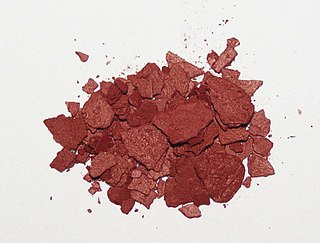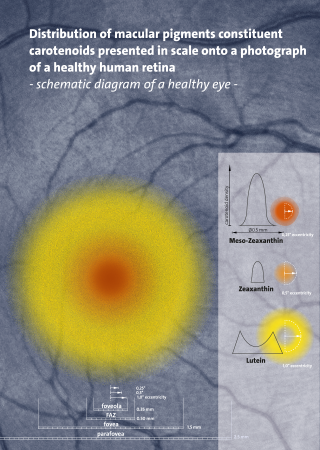
Lycopene is an organic compound classified as a tetraterpene and a carotene. Lycopene is a bright red carotenoid hydrocarbon found in tomatoes and other red fruits and vegetables.

Carotenoids are yellow, orange, and red organic pigments that are produced by plants and algae, as well as several bacteria, archaea, and fungi. Carotenoids give the characteristic color to pumpkins, carrots, parsnips, corn, tomatoes, canaries, flamingos, salmon, lobster, shrimp, and daffodils. Over 1,100 identified carotenoids can be further categorized into two classes – xanthophylls and carotenes.

Xanthophylls are yellow pigments that occur widely in nature and form one of two major divisions of the carotenoid group; the other division is formed by the carotenes. The name is from Greek: xanthos (ξανθός), meaning "yellow", and phyllon (φύλλον), meaning "leaf"), due to their formation of the yellow band seen in early chromatography of leaf pigments.

Astaxanthin is a keto-carotenoid within a group of chemical compounds known as terpenes. Astaxanthin is a metabolite of zeaxanthin and canthaxanthin, containing both hydroxyl and ketone functional groups. It is a lipid-soluble pigment with red coloring properties, which result from the extended chain of conjugated double bonds at the center of the compound. The presence of the hydroxyl functional groups and the hydrophobic hydrocarbons render the molecule amphiphilic.
The ionones, from greek ἴον ion "violet", are a series of closely related chemical substances that are part of a group of compounds known as rose ketones, which also includes damascones and damascenones. Ionones are aroma compounds found in a variety of essential oils, including rose oil. β-Ionone is a significant contributor to the aroma of roses, despite its relatively low concentration, and is an important fragrance chemical used in perfumery. The ionones are derived from the degradation of carotenoids.

Phytofluene is a colorless carotenoid found naturally in tomatoes and other vegetables. It is the second product of carotenoid biosynthesis. It is formed from phytoene in a desaturation reaction leading to the formation of five conjugated double bonds. In the following step, addition of carbon-carbon conjugated double bonds leads to the formation of z-carotene and appearance of visible color.
CRT is the gene cluster responsible for the biosynthesis of carotenoids. Those genes are found in eubacteria, in algae and are cryptic in Streptomyces griseus.
In enzymology, a carotene 7,8-desaturase (EC 1.14.99.30) is an enzyme that catalyzes the chemical reaction
In enzymology, a neoxanthin synthase is an enzyme that catalyzes the chemical reaction:

Phytoene is a 40-carbon intermediate in the biosynthesis of carotenoids. The synthesis of phytoene is the first committed step in the synthesis of carotenoids in plants. Phytoene is produced from two molecules of geranylgeranyl pyrophosphate (GGPP) by the action of the enzyme phytoene synthase. The two GGPP molecules are condensed together followed by removal of diphosphate and proton shift leading to the formation of phytoene.

Phaseic acid is a terpenoid catabolite of abscisic acid. Like abscisic acid, it is a plant hormone associated with photosynthesis arrest and abscission.
Antheraxanthin is a bright yellow accessory pigment found in many organisms that perform photosynthesis. It is a xanthophyll cycle pigment, an oil-soluble alcohol within the xanthophyll subgroup of carotenoids. Antheraxanthin is both a component in and product of the cellular photoprotection mechanisms in photosynthetic green algae, red algae, euglenoids, and plants.

15-cis-phytoene desaturases, are enzymes involved in the carotenoid biosynthesis in plants and cyanobacteria. Phytoene desaturases are membrane-bound enzymes localized in plastids and introduce two double bonds into their colorless substrate phytoene by dehydrogenation and isomerize two additional double bonds. This reaction starts a biochemical pathway involving three further enzymes called the poly-cis pathway and leads to the red colored lycopene. The homologous phytoene desaturase found in bacteria and fungi (CrtI) converts phytoene directly to lycopene by an all-trans pathway.
All-trans-zeta-carotene desaturase is an enzyme with systematic name all-trans-zeta-carotene:acceptor oxidoreductase. This enzyme catalyses the following chemical reaction
Phytoene desaturase (neurosporene-forming) is an enzyme with systematic name 15-cis-phytoene:acceptor oxidoreductase (neurosporene-forming). This enzyme catalyses the following chemical reaction
Phytoene desaturase (zeta-carotene-forming) is an enzyme with systematic name 15-cis-phytoene:acceptor oxidoreductase (zeta-carotene-forming). This enzyme catalyses the following chemical reaction
Phytoene desaturase (3,4-didehydrolycopene-forming) is an enzyme with systematic name 15-cis-phytoene:acceptor oxidoreductase (3,4-didehydrolycopene-forming). This enzyme catalyses the following chemical reaction

Phytoene desaturase (lycopene-forming) are enzymes found in archaea, bacteria and fungi that are involved in carotenoid biosynthesis. They catalyze the conversion of colorless 15-cis-phytoene into a bright red lycopene in a biochemical pathway called the poly-trans pathway. The same process in plants and cyanobacteria utilizes four separate enzymes in a poly-cis pathway.
The squalene/phytoene synthase family represents proteins that catalyze the head-to-head condensation of C15 and C20 prenyl units (i.e. farnesyl diphosphate and genranylgeranyl diphosphate). This enzymatic step constitutes part of steroid and carotenoid biosynthesis pathway. Squalene synthase EC (SQS) and Phytoene synthase EC (PSY) are two well-known examples of this protein family and share a number of functional similarities. These similarities are also reflected in their primary structure. In particular three well conserved regions are shared by SQS and PSY; they could be involved in substrate binding and/or the catalytic mechanism. SQS catalyzes the conversion of two molecules of farnesyl diphosphate (FPP) into squalene. It is the first committed step in the cholesterol biosynthetic pathway. The reaction carried out by SQS is catalyzed in two separate steps: the first is a head-to-head condensation of the two molecules of FPP to form presqualene diphosphate; this intermediate is then rearranged in a NADP-dependent reduction, to form squalene:
Lycopene β-cyclase is an enzyme with systematic name carotenoid beta-end group lyase (decyclizing). This enzyme catalyses the following chemical reaction

















